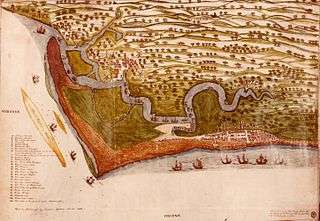River Alde
| Alde | |
| River | |
 The river at Aldeburgh | |
| Country | England |
|---|---|
| Region | Suffolk |
| Tributaries | |
| - right | River Ore |
| Source | |
| - location | Brundish |
| - elevation | 60 m (197 ft) |
| - coordinates | 52°16′48″N 1°18′17″E / 52.2799°N 1.3048°E |
| Mouth | |
| - location | North Sea |
| - elevation | 0 m (0 ft) |
| - coordinates | 52°02′24″N 1°27′39″E / 52.0401°N 1.4607°ECoordinates: 52°02′24″N 1°27′39″E / 52.0401°N 1.4607°E |
| Length | 54.4 km (34 mi) |
 Location of the river mouth within Suffolk | |

The River Alde is a river in Suffolk, England passing by Snape and Aldeburgh. The river is known as the River Ore as it approaches Orford[1] and flows by a shingle spit before emptying into the North Sea.
The source of the River Alde is near Laxfield in the same area as the River Blyth. Initially a stream, it becomes tidal and widens considerably when it reaches Snape. It meanders east past Aldeburgh, after which this part of the river was named.[2] Though it once entered the sea near Orford, the mouth of the river has now been pushed some five miles further south as shingle has accumulated over hundreds of years after which it splits to form Havergate Island and is joined by its tributary, the Butley River, before reaching the sea at Shingle Street.
During Tudor times, the river served as a port from which four ships were launched to fight against the Spanish Armada.[3] The river no longer serves as a port but as an area for yacht club members to gather to sail.
River Ore
The River Ore is the name of the final section of around 11 kilometres (6.8 mi) of the River Alde from just above Orford to the sea.[4] It has one tributary, the Butley River, and Havergate Island is found at their confluence.
The lower reaches of the river passes through marshland and shingle or sand beaches, most of which is now owned by the National Trust as the "Orford Ness National Nature Reserve". Before the National Trust took ownership of this land, it was the site of a secret military base where tests with radar were carried out during the Cold War.
The shingle spit that blocks the river, Orford Ness, is now some 10 miles in length and is owned by the National Trust,[5] previously being a secret military base where tests with radar were carried out.[6] The main area through which the River Alde flows is open countryside in private ownership, much of it arable farmland.
The tidal reaches (below Snape Bridge) are within the Suffolk Coast and Heaths Area of Outstanding Natural Beauty, as well as being a Site of Special Scientific Interest,[7][8] a designated Special Area of Conservation[9] and a Special Protection Area.[10] An RSPB reserve, Boyton Marshes, is situated between the River Ore and the Butley River. A registered charity, the Alde & Ore Association, exists to "preserve and protect for the public benefit the Alde, Ore and Butley Creek rivers and their banks from Shingle Street to their tidal limits".[11]
The novel What I Was by Meg Rosoff is set on the coastline where the River Ore meets the sea.
Tributary
The River Ore is also the name of a tributary of the Alde that flows around 18 kilometres (11 mi) from west of Dennington south and east through Framlingham, Parham and Marlesford, flowing into the River Alde to the north of Blaxhall.[12]
Alde Mudflats
An area of mudflats 22 hectares (54 acres) on the southern side of the river, near Iken, is managed by the Suffolk Wildlife Trust as their Alde Mudflats nature reserve however there is no public access to prevent a human disturbance.[13]
See also
References
- ↑ Ordnance Survey - Leisure Series Map 156
- ↑ Theo Clarke and Nick Sinclair, Ebb & Flow River Heritage Walks (Ipswich: Leveretts, 2008) ISBN 978-0-9559958-0-4.
- ↑ "Alde and Ore Association-Protecting Aldeburgh's River". Retrieved 2007-12-29.
- ↑ Ordnance Survey Leisure series map 156
- ↑ "Orford Ness National Nature Reserve". National Trust. Retrieved 2007-12-29.
- ↑ "The mystery of Orford Ness". BBC Suffolk. Retrieved 2007-12-29.
- ↑ Alde-Ore Estuary, SSSI citation, Natural England. Retrieved 2013-05-29.
- ↑ "Guidance for the Management of Coastal Vegetated Shingle". Retrieved 2007-12-30.
- ↑ "Alde, Ore and Butley Estuaries". Retrieved 2007-12-30.
- ↑ "Suffolk Coast and Heaths - Caring for the coast and its special wildlife". Suffolk Coasts and Heaths. Retrieved 2007-12-30.
- ↑ "Alde and Ore Association". Retrieved 2012-01-27.
- ↑ Ordnance Survey of Great Britain
- ↑ Alde Mudflats, Suffolk Wildlife Trust. Retrieved 2013-05-29.
External links
| Wikimedia Commons has media related to River Alde. |
- Joint Nature Conservation Committee - Alde, Ore and Butley Estuaries
- Orford Ness National Nature Reserve information at the National Trust
- RSPB - Boyton Marshes
- The Alde & Ore Association
- Aldeburgh Yacht Club
- Orford Sailing Club
- Slaughden Sailing Club
- Boyton Marshes guide from the RSPB